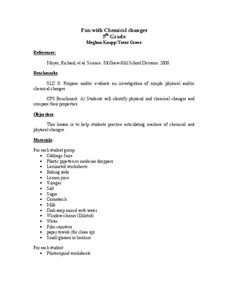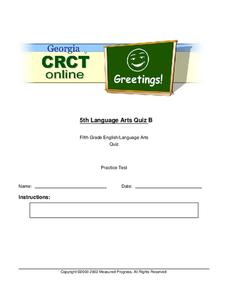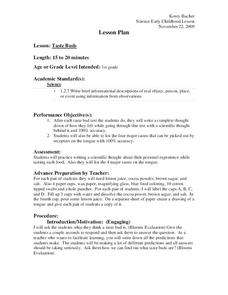Curated OER
Strawberry DNA extraction
Students study the basic function of DNA and then extract it from strawberries. In this DNA extraction lesson students examine DNA and see why the extraction of it is so important to scientists.
Curated OER
The History of Maple Syrup
Students explore the process of harvesting maple syrup. In this science and history lesson, students make their own maple syrup and create a picture book that shows the Native American and American pioneer methods of making the syrup.
Curated OER
Advanced Critical Reading: Salt
In this critical reading worksheet, students read a passage regarding salt then answer three questions based on the reading.
Curated OER
Equilibrium Practice
In this chemical reactions worksheet, students determine solubility product expressions, equilibrium constants, and equilibrium concentrations. This worksheet has 15 multiple choice questions and 3 problems to solve.
Curated OER
What's Cooking?
Students investigate solar energy by making sun tea. In this ecology and solar energy lesson, students prepare traditional tea and "sun" tea, then record and graph data comparing color, clarity, smell and taste.
Alabama Learning Exchange
Observation of Yeast Growth
Middle schoolers build an apparatus to look at how yeast cells grow by converting food to energy. They observe yeast both with and without food and see how yeast produces carbon dioxide.
Curated OER
DNA Extraction From Onion
Students extract DNA from an onion using household equipment and supplies.
Curated OER
Rainbow Electrophoresis Lab
Students are introduced to the principles of gel electrophoresis. They practice loading gels and pipetting. In this laboratory activity, food color is separated into constituent pigments. The lab can be run with standard electrophoresis...
Curated OER
Paper Chromatography-Chemical and Mechanical
Students perform paper chromatography to determine pigments in plants. In this paper chromatography lesson plan, students isolate leaf pigments, prepare a chromatogram and place their chromatogram in a solvent to separate the pigments....
Curated OER
Chromotography
In this chromatography learning exercise, students are given markers, filter paper and a solvent to separate the pigments found in each marker. Students create a chromatogram for each marker.
Curated OER
Fun With Chemical Changes
Fifth graders observe and identify the differences between chemical and physical changes. In small groups they mix different substances together in glass beakers, and identify which had a chemical change, supporting their statements...
Curated OER
Fifth Grade English/Language Arts Quiz
In this language learning exercise, 5th graders complete multiple choice questions about sentence structure, commas, parts of speech, and more. Students complete 15 questions.
Curated OER
Discovering Cohesion, Adhesion and Surface Tension
Students investigate cohesion, adhesion and surface tension through observations and lab experiments. In this cohesion, adhesion and surface tension lesson plan, students rotate to 5 stations around the room and experiment at each...
Curated OER
Building Challenges
Students work together to complete different building challenges. They use prior knowledge to build tunnels and different types of bridges. They share their creations with the group.
Curated OER
H2O2 Decomposition Lab II
Students conduct an oxidation experiment in which they must determine how much hydrogen peroxide (H2O2) is actually in a store-bought solution of H2O2.
Curated OER
Chemical Fun
Fifth graders observe and conduct a variety of experiments to differentiate between physical and chemical changes. They mix cabbage juice with different liquids and record their observations on a chart. Students write down their...
Curated OER
Collecting and Classifying Pollen
Students collect and analyze pollen from different species of plants. In small groups, they classify pollen according to shape, size and physical characteristics. They draw the basic anatomy of flowering plants and create a dichotomous...
Curated OER
Taste Buds
First graders taste a variety of items and record a full sentence about the way they taste. In this taste buds lesson, 1st graders predict and then taste various items. Students draw a picture of the tongue and show the part...
Curated OER
Xinjiang: A Bi-Cultural Perspective
Twelfth graders research the affects the Chinese Nuclear Program has had on the environment and the health of the Uighur minority.
Curated OER
Make Sense of Nature
Students participate in this program that heightens their awareness and curiosity of nature as well as their sense of adventure and exploring new surroundings. They identify and choose an object from nature after exploring it with other...
Curated OER
Why Don't Whales Have Legs?
Learners are given a variety of materials and are asked to design a heat loss experiment that results in a reasonable explanation of "Why don't whales have legs?" students work with the theory of natural selection.
Curated OER
Examine an Ecosystem
Students examine an ecosystem and record what they see. In this ecosystem instructional activity students use a worksheet to help them identify the organisms in their ecosystem.
Curated OER
Observation and Stimulation of bioluminescence and chemiluminescence
Students are introduced to chemical reactions, reaction rates, chemiluminescence, fluorescence and bioluminescence. They use glow sticks are used to demonstrate the effect of temperature on the rates of chemical reactions. Pupils recall...
Curated OER
Designing a Study
Students explore features to consider when designing a scientific study. In this science research lesson, students examine different methods of data collection and consider which method would be appropriate for determining how many types...

























